In the explosive world of weightlifting, the untrained eye may see nothing more than brute force and raw strength. But behind every record-breaking lift and powerful movement lies a discipline rooted in science, self-awareness, and razor-sharp precision. For elite weightlifters and even serious recreational ones mastering form isn’t optional; it’s the foundation of both peak performance and long-term physical health.
As the sport has evolved, so has the understanding of how crucial precision is in every aspect of training from movement patterns and muscle activation to recovery and mental discipline. And perhaps more importantly, it’s become clear that precision is what separates great lifters from those sidelined by injury.
Why Form is the Foundation
Unlike many fitness routines that prioritize volume or intensity, weightlifting begins with and constantly returns to technique. Lifts like the snatch, clean and jerk, or even a simple back squat demand full-body coordination and optimal mechanics. Each movement is a symphony of balance, timing, and control.
The snatch, for example, requires a lifter to move a loaded barbell from the ground to overhead in one continuous motion. Without perfect form, the lifter risks failing the lift or, worse, causing injury to the shoulders, back, or knees. At the professional level, athletes spend years mastering these complex motions before attempting world-class weights.
Key technical elements include:
- Foot placement for balance and force distribution
- Grip width and hand positioning
- Spinal alignment to protect the lower back
- Bar path tracking to maximize mechanical efficiency
- Joint angle control for safe and powerful transitions
Even micro-errors in these areas can result in failed lifts, muscular strain, or long-term joint wear.
The Role of Coaching and Technology
Modern weightlifters benefit from more than just repetition they utilize advanced tools and professional guidance to perfect form. High-level athletes often work with specialized coaches who analyze every lift, frame by frame, using video playback, motion capture, and force plates that measure balance and pressure.
These tools help athletes identify breakdowns in technique that are too subtle for the naked eye. Coaches then design corrective drills, mobility work, or cueing strategies to realign movement. A slight tilt of the hips or delay in pulling under the bar can be caught and corrected before it turns into an injury or habit.
Injury Prevention Through Precision
The number one reason weightlifters obsess over form isn’t just to lift heavier it’s to avoid injury.
Weightlifting places immense stress on the spine, shoulders, knees, and hips. Common injuries include:
- Lumbar strains from poor deadlift or squat technique
- Rotator cuff issues due to unstable overhead positions
- Knee tendinitis from incorrect tracking or lack of depth control
- Wrist and elbow pain from poor bar positioning or wrist mobility
However, these injuries are not inevitable. In fact, studies show that Olympic weightlifting has one of the lowest injury rates among strength sports largely because of the strict focus on technical form and movement quality. Precision is the best defense against overuse injuries and acute trauma.
Lifters often follow structured warm-up protocols, prehabilitation exercises, and joint mobility routines to support their lifting. Exercises such as goblet squats, overhead squats, hip openers, and banded shoulder drills are frequently used to maintain the range of motion and muscular balance.
The Mental Discipline Behind Technical Mastery
What makes precision even more powerful is that it builds mental discipline. Top-level lifters aren’t just physically strong they are laser-focused, highly coachable, and detail-oriented. Developing flawless technique takes time, patience, and a deep willingness to accept critique.
Weightlifting teaches athletes to value process over ego. Adding five more pounds to the bar doesn’t matter if form breaks down. That mindset prioritizing mastery over momentary progress is why many elite lifters have careers that span decades.
The focus on precision also builds resilience. Lifters must learn how to respond to failure, adjust technique, and stay consistent over time. It’s a powerful parallel to personal growth the smallest improvements often lead to the biggest breakthroughs.
Beyond the Platform: Lessons for Everyone
You don’t need to be an Olympian to benefit from precision in weightlifting. Whether you’re a beginner, CrossFit athlete, or bodybuilder, investing time in proper form will:
- Enhance results by improving mechanical efficiency
- Reduce injury risk, keeping you training consistently
- Boost confidence as movements feel more natural and powerful
Many recreational lifters fall into the trap of chasing numbers or copying popular routines without foundational skills. A better approach is to slow down, work with knowledgeable coaches or resources, and build strength from a technically sound base.
Precision Is Power
In weightlifting, precision isn’t just a detail it’s the defining trait of greatness. From mastering technique and training the nervous system to preventing injury and building mental discipline, precision turns lifting into both a science and an art.
Strength may get you started, but it’s precision that keeps you progressing safely, sustainably, and successfully.

